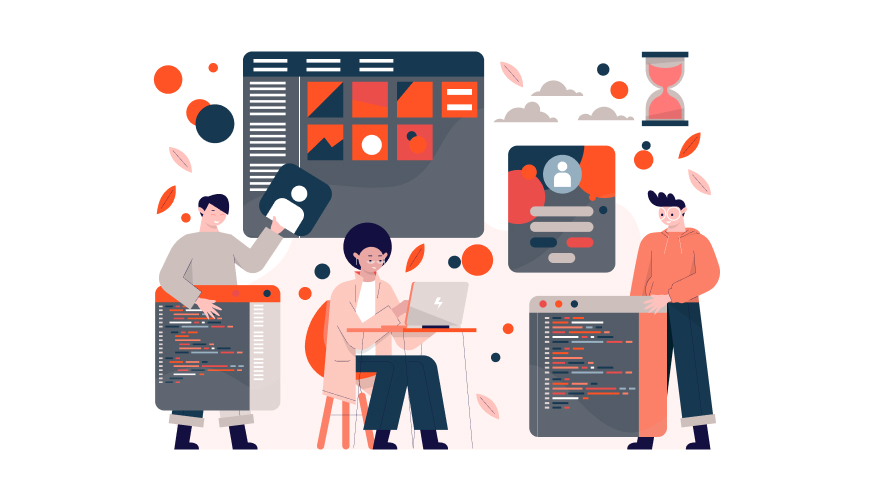
In the world of programming, a framework is like a set of powerful tools that provide a solid foundation for creating reliable and well-structured software and systems. This guide will give you information about frameworks by explaining their essence in simple terms, highlighting their necessity, and exploring a range of real-world examples.
| Table of Contents |
In general terms, a framework is a structured environment that provides developers with a foundation to build applications. It consists of predefined libraries, tools, and guidelines that assist in streamlining the development process. Think of a framework as a skeleton or a blueprint that sets the structure and guidelines for building a web application.
A framework is a software package that aids developers in creating applications efficiently and effectively.

A good framework possesses several key features that contribute to its effectiveness and usefulness in software development.
Modularity:A good framework offers a modular structure, allowing developers to divide their applications into separate, reusable components. Modularity promotes code organisation, maintainability, and reusability, making it easier to manage and scale the application.
Flexibility:Frameworks should provide flexibility in terms of customization and adaptability to different project requirements. They should allow developers to extend or modify the existing functionality to suit specific needs without imposing rigid constraints.
Scalability:Scalability is crucial as applications need to handle increased user loads and data volumes. A good framework should support horizontal and vertical scaling, allowing applications to grow seamlessly as demands increase.
Performance Optimization:Performance is a critical factor in delivering a fast and responsive application. A good framework incorporates performance optimization techniques and features, such as caching, lazy loading, and efficient database queries, to ensure optimal application speed and efficiency.
Security:A good framework provides built-in security mechanisms and features to protect against common vulnerabilities, such as cross-site scripting (XSS) and SQL injection attacks. It should also support secure coding practices and offer guidelines for secure application development.
Compatibility and Integration:Compatibility with different operating systems, databases, web servers, and third-party libraries is essential. A good framework supports seamless integration with other tools and technologies, allowing developers to leverage existing resources and integrate with external services or APIs.
Maturity and Longevity:The maturity and longevity of a framework indicate its stability, reliability, and long-term viability. A good framework has a proven track record, a large user base, and a strong ecosystem of plugins, extensions, and community contributions. It demonstrates ongoing development and support, reducing the risk of abandonment.
Ease of Use:Finally, a good framework should have a relatively low learning curve, making it accessible to developers with varying skill levels. It should provide intuitive APIs, clear syntax, and effective abstractions that simplify common tasks and boost developer productivity.
Also, read more about What is API?
A typical framework consists of several key components that contribute to its functionality:

Frameworks, as you might expect, can be used for a wide range of development projects. Frameworks are available for software development, web development, API work, and even data science.

Frameworks bring several advantages to web development projects. Here are a few key benefits:
Efficiency and Productivity: By providing pre-built components and libraries, frameworks enable developers to work faster and more efficiently. They eliminate the need to reinvent the wheel, allowing developers to focus on solving specific problems rather than writing boilerplate code.
Structure and Organization: Frameworks promote a structured approach to development. They often enforce coding conventions and architectural patterns, ensuring consistency across the project.
Community and Support: Frameworks usually have a vibrant community of developers who actively contribute to their growth. This means you can benefit from a vast array of documentation, tutorials, forums, and third-party packages. Leveraging the collective knowledge and experience of the community can be immensely helpful during development
Security and Best Practices: Frameworks often integrate security features and follow industry best practices. They provide built-in mechanisms for handling common security concerns, such as input validation and protection against common web vulnerabilities, reducing the risk of security breaches.
Also, read more about difference between AI and Machine Learning

Choosing the right framework is a critical decision when it comes to developing software applications. With numerous options available on the market, it can be overwhelming to determine which framework will best suit your project's requirements.
Understanding Frameworks: Before diving into the process of selecting a framework, it's essential to have a clear understanding of what frameworks are and how they function. In the context of software development, a framework is a structured and reusable codebase that provides developers with a set of tools, guidelines, and functionalities to streamline the creation of applications.
Project Requirements: To pick the right framework, start by defining your project requirements. Consider factors such as its complexity, scalability needs, expected user base, and time-to-market. Identifying these requirements will help you narrow down your options and choose a framework that aligns with your project's specific demands.
Researching Frameworks: Once you have a clear understanding of your project requirements, begin researching available frameworks. Explore popular frameworks like React, Angular, Vue.js, Laravel, Django, Ruby on Rails, and others that are relevant to your project's tech stack. Look into their features, capabilities, and use cases to determine which frameworks have a track record of success for projects similar to yours.
Compatibility and Scalability: Compatibility and scalability are crucial considerations when selecting a framework. Ensure that the framework you choose is compatible with your chosen programming language, databases, and any other tools or technologies your project requires. Additionally, assess the framework's scalability options to ensure it can handle your application's growth and future requirements.
Community Support: Community support plays a vital role in the success of a framework. A vibrant and active community ensures continuous development, bug fixes, and the availability of third-party libraries and extensions. Join forums, online communities, and social media groups related to the frameworks you are considering. Assess the responsiveness and helpfulness of the community members to gauge the level of support you can expect.
Performance and Security: Performance and security are critical aspects of any software application. Look for frameworks that prioritise performance optimization and have security mechanisms in place. Consider factors such as speed, efficiency, and the ability to handle large-scale applications. Additionally, check for any security vulnerabilities or history of security breaches associated with the frameworks under consideration.
Pros and Cons: After gathering all the necessary information, carefully weigh the pros and cons of each framework. Consider factors such as ease of use, flexibility, maintainability, community adoption, industry trends, and long-term viability. Create a comparative analysis chart or list to visualise and compare the strengths and weaknesses of each framework.
You will be familiar with what and how frameworks revolutionise the way applications are created, offering developers a pathway to success.
Also, read more about why software testing is important?
Through this blog, you will become familiar with what is a framework in web development and mobile app development. It empowers developers to streamline their workflow, harness the power of pre-built components, and tap into a wealth of resources and support. By leveraging frameworks, developers can unlock new dimensions of efficiency, which enable them to craft remarkable applications that transcend expectations. So, dive into the world of frameworks, and witness the transformation as your development journey reaches new heights of success.
IPIX Technologies is a web development company in India that provide a solid foundation for building a successful business. Our expert team of professionals with their hard work and determination will pave the way for extraordinary accomplishments. Feel free to let us help you pursue your goals. Experience the power of innovative web design with IPIX Technologies.